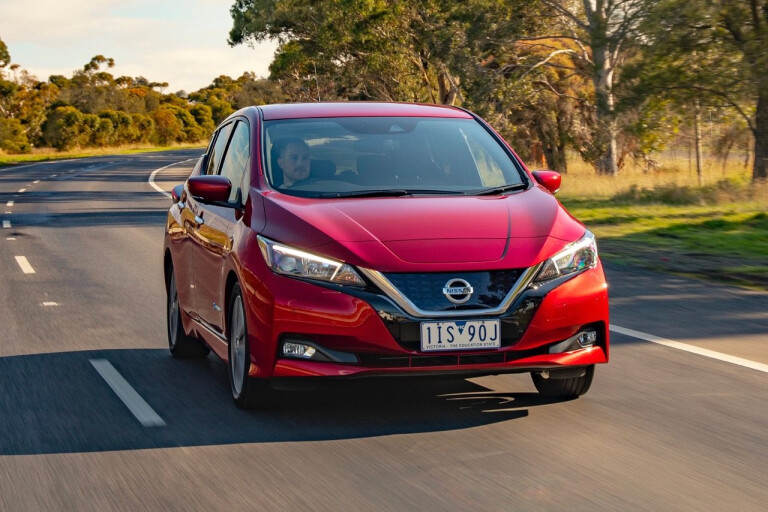
What’s in the garage?
Now in its second generation, the Nissan Leaf remains as one of the most successful ‘affordable’ EVs. Actually, it is the best-selling EV globally. The new model is already proving popular down under, too, with Nissan finding driveways for 109 Leafs in July. Considering Toyota shifted 15 of its Prius and Hyundai sold 35 Ioniqs, it’s an impressive start.
The second-gen car uses the same 40kWh battery pack that replaced the first-gen’s 24kWh version halfway through its lifecycle. But more efficient inverter and battery technology means overall range has increased by about 100km to 270km in WLTP testing. Using lithium ion, the battery pack is no bigger or heavier than the original, while the new AC synchronous motor now has 110kW and 320Nm. Three charging options are available from 240v mains power, a circa $3K 7kWh wallbox, or a public 50kWh DC fast charger. From zero, you can have as much as 80 percent charge in 60 minutes using a fast charger.
There’s only one $49,990 variant, but it comes highly specced. Standard kit includes items like lane keeping, blind-spot monitoring, AEB, traffic-sign recognition, auto high beam, front and rear parking sensors, reversing camera, driver-attention alert, an 8.0-inch touchscreen with sat-nav, heated leather seats (front and rear), heated steering wheel and radar cruise control. Sadly, there’s no stripped-out base model if all you care about is the efficient electric powertrain.

What we reckon
| I want to like it more than I do. However, that’s more a blanket EV opinion rather than one zeroing in on the Nissan Leaf. The Leaf has a lot of potential. Its smart battery means a greater range and auxiliaries such as climate control have less of an effect on overall range compared some other EVs on the market. It has the ability to be used in a vehicle-to-grid scenario, which is complex, fascinating technology that could be of vital use in the future. However, the Leaf is expensive and it doesn’t feel as premium as the price suggests despite being feature-packed. And with a personal inability to charge from home, the whole experience doesn’t quite fit for me – yet. |
| The work done by the Nissan Leaf in bringing electric mobility to the mainstream cannot be understated, and for that it deserves plenty of kudos. However, bring it out of the vacuum and into the real world and it begins to lose its sheen. Its price tag premium over ICE-powered rivals can be difficult to swallow, but for the EV convert that may not be such an issue. What can’t be whisked under the EV carpet though is its poor ride and steering, which makes it harder to love day-to-day. With more rivals arriving seemingly every month, there are better options for the affordable EV buyer in Australia - though most are (a little) more expensive. |
| It’s hard to see the global success translating to meaningful sales in Australia. It’s a circa-$33K hatchback costing $50K because of its electric powertrain, and demands that buyers be prepared to pay a hefty premium for the technology and lower running costs. Yes, it works well in an urban environment, where the instant torque, ultra-quiet operation, absorbent ride and re-gen braking can all shine. But it’s compromised as a touring car. The great open road also exposes its unresolved damping and steering rack rattle through bumpy sweepers. Get the touring range up to 350km, sort out the chassis, and trim the price to $43,000, then let’s discuss. |
Review
Power and performance
Okay, let’s not get ahead of ourselves and call the Leaf a hot hatch – its temperament isn’t even overtly warm. But the Leaf isn’t slow, far from it. On paper the 110kW power figure and quoted 0-100km/h of 7.9sec raises few eyebrows, yet the 320Nm torque figure should; especially given it is instantaneous. In reality the Leaf feels far better than brisk within the CBD, but you’re also not left wanting for a surge in power for highway overtakes.
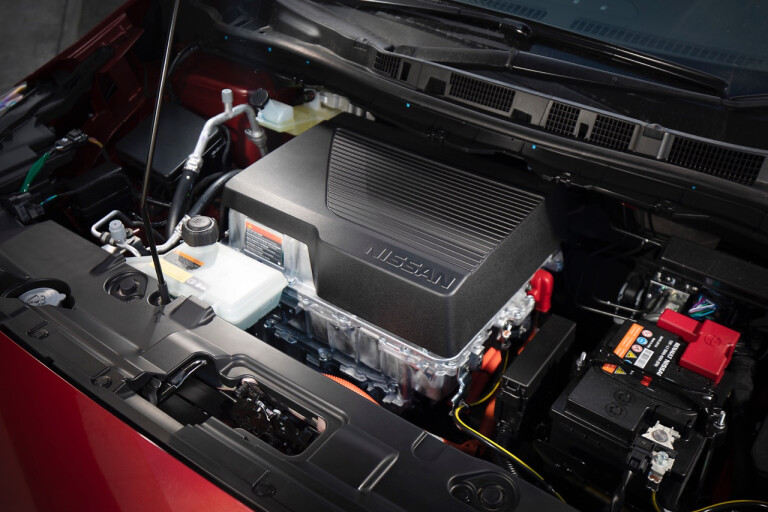
Range anxiety is still an issue if you want to explore the open road. Fully charged we’ve seen as much as 288km of overall range, but a lack of rapid chargers for now in rural areas cancels out a big drive. Plus, with a single-speed reduction gear, cruising at 100km/h chews the battery at an increased rate. Thanks to the bigger battery pack, opting to use the climate control ‘only’ cuts into overall range by about 15-20km. We’ve previously tested the Leaf’s battery economy at 15.4kWh/100km.
Ride and handling
The taut gen-two Leaf isn’t ham-fisted dynamically. Just don’t get too excited about the prospect of an engaging 1560kg electric hatchback and you won’t be disappointed. The ride quality is mostly compliant, erring on the firm side, while the damping could use some further tuning. The immediacy of the electric motor makes nipping in and out of traffic not only easy, but a bit of fun, too. Fellow motorists won’t even hear you coming... literally.
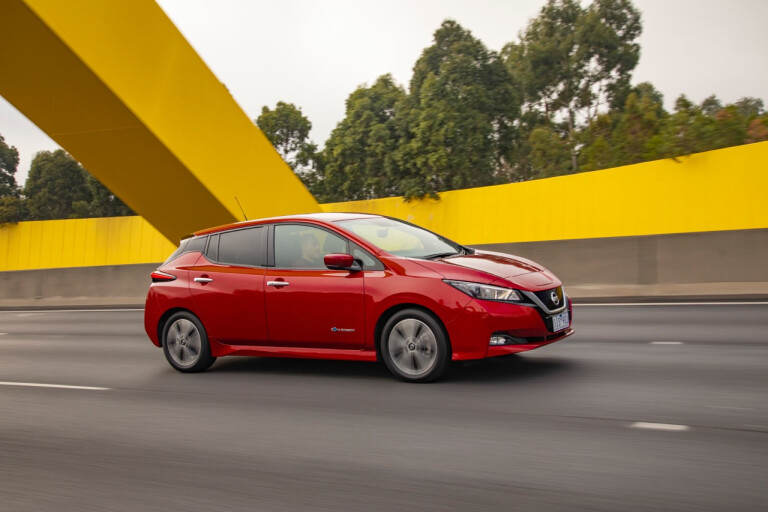
The downside of all the Newtons is torque steer… and the fact that the Leaf runs on eco-centric tyres, resulting in wheel spin if you’re a bit too heavy footed on the go pedal. This is then followed up by heavy intervention from the traction control. In wet conditions, you do actually have to be judicious with your inputs. At the other end of the scale the e-pedal regenerative braking is strong and takes some getting used to. Once you do though, you can feasibly get away with not using the brake pedal at all, saving on brake pads for when it comes time for a service.
Interior and Comfort
Dimensionally bigger than the first-gen hatch, the Leaf is spacious and comfortable inside. As mentioned earlier, it isn’t short on spec, either. And the new graphics on the infotainment screen (which supports Apple CarPlay and Android Auto) are a welcome addition for Nissan. Being an EV you get some cool consumption/range displays that are actually useful, and the overall NVH is surprisingly good given there’s no combustion engine to drown out tyre roar. There are pleasing comfort options like the heated seats and steering wheel, but, ultimately, the Leaf doesn’t look or feel like a $50K hatchback.
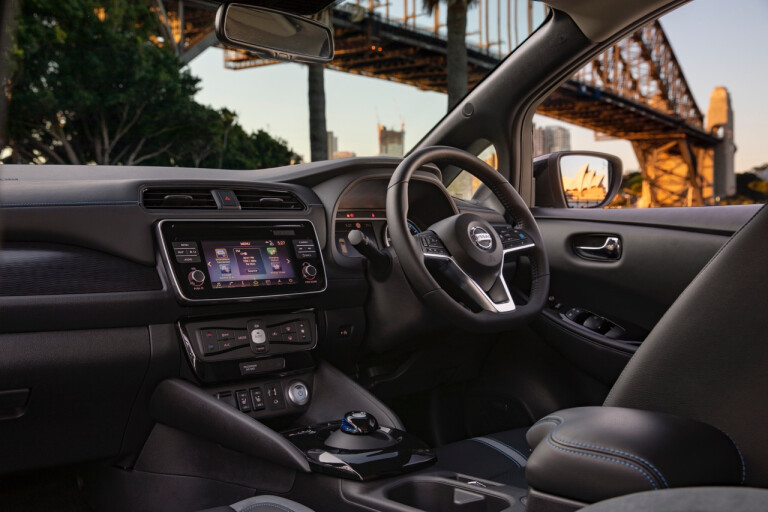
Getting comfortable behind the wheel is made difficult by a lack of reach adjustment for the steering wheel, while the seating position is set a little too high and without much adjustment. The same goes for the rear foot wells, creating a knees-up arrangement that’s unpleasant for taller passengers. The back seats do fold in a 60/40 fashion, but doing so leaves a big load lip to the 435-litre boot – which also contains an awkwardly placed Bose subwoofer. Rounding out the gripes is a foot-operated park brake.
VERDICT
Once you get over range anxiety and the fact the Leaf requires a new way of refuelling, it is entirely normal to live with as a city-dwelling commuter. It’s only when you try pushing past city limits that Australia’s lack of charging infrastructure becomes truly apparent. It’s also hard to forget the price of admission despite the monetary benefits throughout its lifecycle. Fifty grand is a lot coin to make back on a hatchback. Sans electric gubbins, you’d expect this type of hatchback to leave you with at least $15K spare change
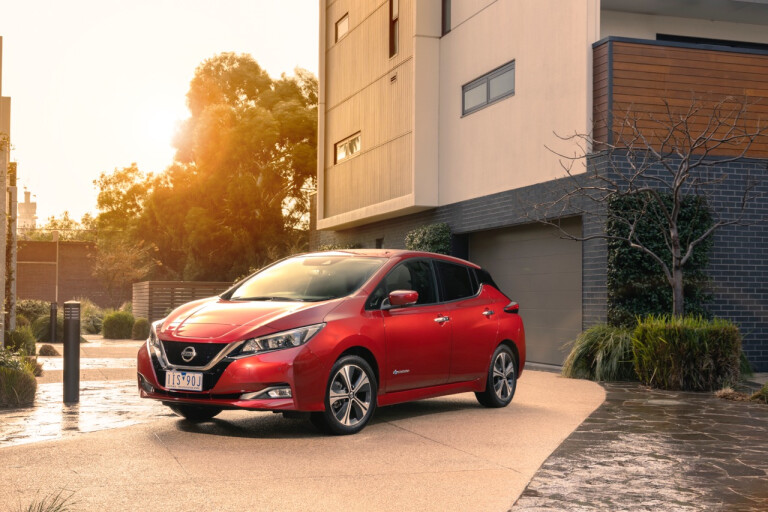
Yet it’s hard not to feel like you’re driving the future. Whether you agree with where it’s going or not is another story. The instant response from the electric motor is perfect for city driving and the seamlessness offers a calming driving experience. Plus, if you’re close to free charge points or can do so at work or from home, living with the Leaf shouldn’t be too dissimilar from any ‘normal’ car.
NISSAN LEAF SPECS
Model: Nissan Leaf
Engine: AC synchronous
Battery: 40kWh lithium ion
Max power: 110kW
Max torque: 320Nm
Transmission: single-speed reduction gear
Weight: 1560kg
0-100km/h: 7.9sec (claimed)
Economy: 15.4kWh/100km (tested)
Plug standard: CHAdeMO
Price: $49,990
On sale: Now

COMMENTS